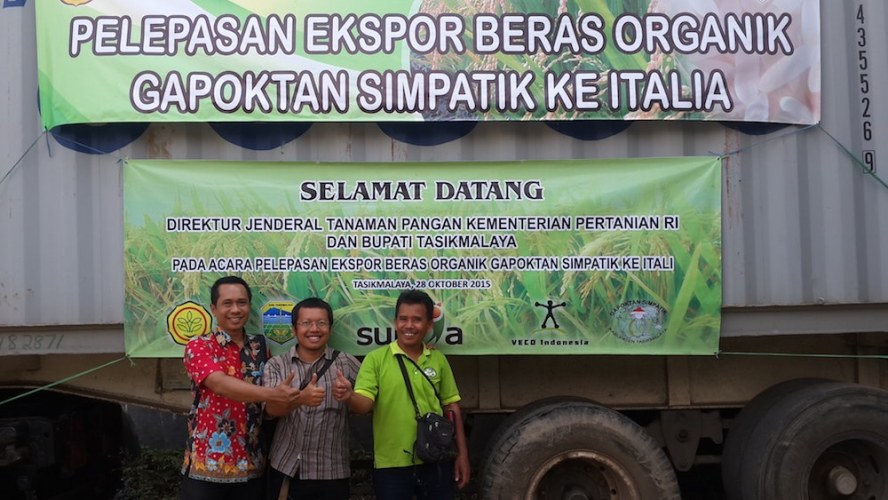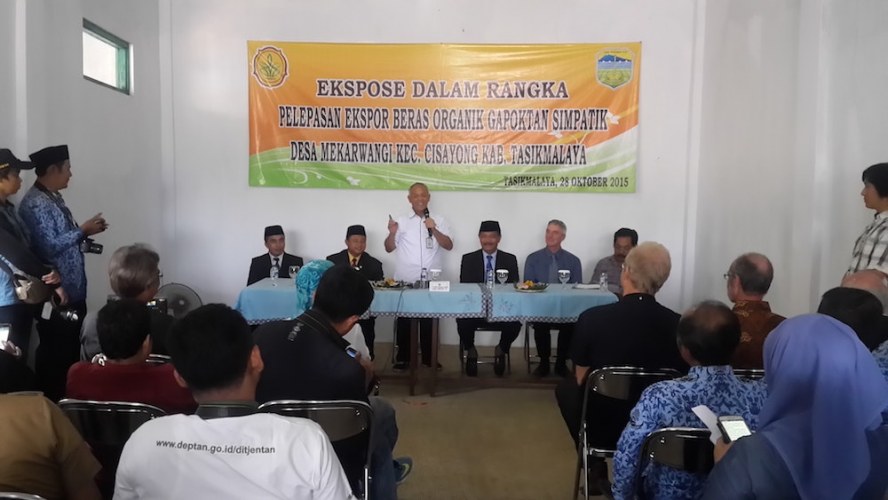Last week, Simpatik farmer organisation in Tasikmalaya, West Java, exported rice to Italy. Simpatik is a VECO Indonesia partner marketing organic rice.
Today, Kompas, Indonesia's largest national newspaper, published an article about the success of the Tasikmalaya organic farmers on its front page. Here, we have re-published an edited version of that article.
Still Prospering Despite Climate Change
This year, extreme climate change has once again spelled despair for food and welfare. But for some farmers and fish farmers in Tasikmalaya district, West Java, this has not been a reason to stop trying. After a long process, their hard work has paid off.

The roar of the rice mill in the Simpatik farmer group organisation processing plant in Cidahu, Mekarwangi village, Cisayong subdistrict was not to be heard, Wednesday (28/10) afternoon. In its place was the sound of dozens of farmers loading hundreds of cardboard boxes filled with organic rice into a truck at the roadside.
Uho Buchori (40), a farmer from Karangjaya, Manonjaya subdistrict, was amongst them. In the humid air of the Tasikmalaya afternoon, sweat was pouring off him. But that didn't stop him loading up the 10 kilogram brown cardboard boxes. "There's 16.8 tons in all, for export to Italy," said Uho.
He was moving the cardboard boxes filled with red, pink and black rice, very carefully. His face was picture of concentration. The rice, branded Rain Forest, made up a large part of the harvests of Uho and other Manonjaya farmers.
In the middle of a long dry season, the organic rice paddies in Manonjaya still managed to produce 6.5 tons to 8 tons per hectare, or almost twice as much as conventional paddy fields.
"The dry season does affect the water supply. But we were able to save water using organic methods and still export this year," he said.
Pioneered in 200, Tasikmalaya organic rice has slowly become a prime commodity. Today 3,000 organic farmers, or around 1 percent of all the farmers in Tasikmalaya, grow rice on around 8,000 hectares of paddy. The total area of paddy in Tasikmalaya is 51,000 hectares.
Six years ago, the farmers took another step forward when they applied for organic land certification from the Institute of Marketology (IMO). The farmers had to have this certificate to be able to export. This year, 256 hectares of paddy passed the test.

Chair of Simpatik Farmer Group Association Uu Saeful Bahri said that the first country to receive Tasikmalaya rice was the United States, which imported 18 tons in 2009. Every year since then, more rice has been exported to more countries.
The additional volumes and export destinations vary from year to year. Between August 2009 and October 2015, 729.8 tons of rice was exported to Belgium, the Netherlands, the United States and Germany. This was no easy task, because these countries have very strict regulations about importing foods from other countries.
The organic farmers' decision not to fight nature was instrumental in this sweet success. Uu explained that the organic farmers had turned their backs on chemical pesticides that tend to degrade the quality of the soil and the rice seed.

The workers who mill the organic rice produced by the Simpatik farmer group members in Tasikmalaya, West Java, were bagging up the organic rice last week. Tasikmalaya organic rice is very popular among consumers overseas. Green management has been key to its success.
Chemical fertiliser has been replaced with manure mixed with sugar palm water, sugar and coconut water, which encourages the growth of microorganisms that fertilise the soil. Also, the farmers repel pests rather than kill them. They use the juice of soursop seeds and leaves against leaf hoppers, tobacco juice against stem borers, and the fruit of Pangium edule (Indonesian: kluwak) and Tinospora tuberculata (Indonesian: bratawali) against blast.
"We're also trying to re-invent rice as a crop that needs water, rather than one that has to be saturated. Now, during the dry season, we can save water," he said.

According to the Head of Rice and Secondary Crop Production at Tasikmalaya District Agriculture and Food Crops Agency Heti Heryati, planting rice seedlings 25 cm apart has multiple benefits. As well as facilitating the absorption of nutrients, it stimulates the growth of the roots of the rice plants. Healthy root growth of 50 to 60 centimetres helps the rice plants tap into scarce water resources.
"The strength of organic rice plants was proved this dry season. Of around 5,000 hectares of paddy field in Tasikmalaya that suffered drought, most were conventional rice fields," he said.
Ministry of Agriculture Director General of Food Crops Hasil Sembiring, when releasing the Tasikmalaya rice for export to Italy, said the success of these organic farmers was of significance for Indonesia. As well as improving farmer incomes, exports inspire the management of the country's huge agricultural potential [Cornelius Helmy].
